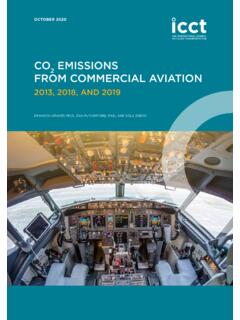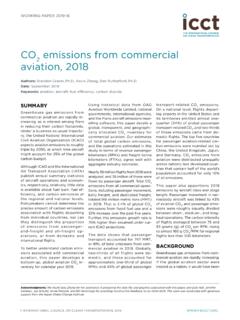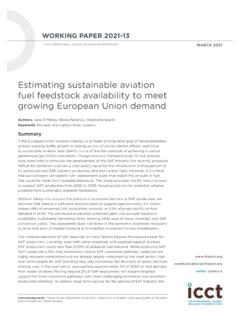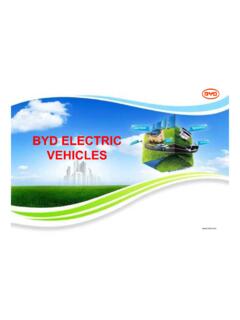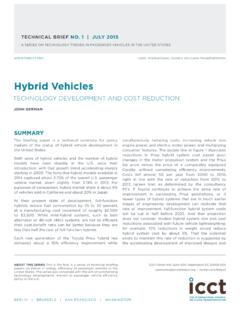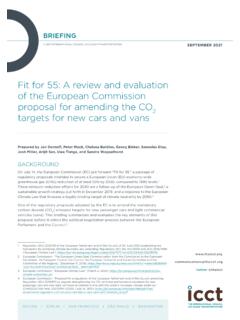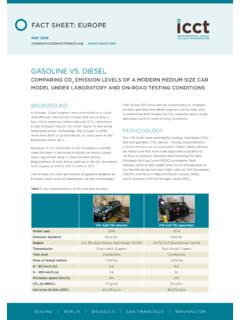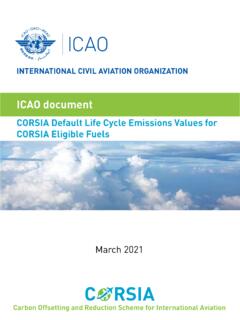Transcription of Effects of battery manufacturing on electric vehicle life ...
1 BRIEFINGFEBRUARY 2018 BEIJING | BERLIN | BRUSSELS | SAN FRANCISCO | WASHINGTONE ffects of battery manufacturing on electric vehicle life- cycle greenhouse gas emissionsThis briefing reviews recent research regarding greenhouse gas emissions from the manufacturing of lithium-ion batteries for electric vehicles. We analyze this research in the overall context of life- cycle emissions of electric cars as compared to conventional internal combustion vehicles in Europe. Finally, we discuss the primary drivers of battery manufacturing emissions and how these emissions could be further mitigated in the vehicles have attracted widespread interest because of their ability to reduce energy consumption and emissions . Governments and manufacturers continue to make new commitments for electric vehicle sales, and the cost of manufacturing electric vehicles continues to fall, making them more competitive with internal combustion vehicles.
2 Advances in lithium-ion battery technologies have been key to the growing success of electric vehicles, and a continued transition to electric drive will necessitate far greater battery production. The scientific understanding of the exact environmental impacts of electric vehicles continues to evolve, and the impacts of battery production on electric vehicles overall emissions is an especially complex topic. Recent studies have investigated the greenhouse gas emissions from battery production, finding a wide range of results and implications. Meanwhile, governments also have begun to consider this issue, and questions have even arisen regarding whether battery life- cycle impacts could be by: Dale Hall and Nic Lutsey2 ICCT BRIEFING integrated into vehicle policy. In this briefing, we review the research literature, analyze the overall life- cycle greenhouse gas emissions impact of electric vehicles, and discuss key related trends into the OF LITERATURE AND KEY ASSUMPTIONSE lectric vehicle battery manufacturing emissions have been studied extensively.
3 Table 1 lists several research studies analyzing the emissions related to electric vehicle battery production. These studies vary in scope and methodology, and find a range of values for electric vehicle greenhouse gas emissions attributable to battery production. As shown in Table 1, the studies indicate that battery production is associated with 56 to 494 kilograms of carbon dioxide per kilowatt-hour of battery capacity (kg CO2/kWh) for electric vehicles. Several of the studies also provide estimates for the equivalent amount of emissions per kilometer driven over the vehicle lifetimes. These generally find 1 2 g CO2 per kilometer per kWh of battery capacity. We emphasize that the table simplifies the analytical findings, which in many cases have more scenarios and results than are basically summarized here.
4 The wide range of values found in these studies indicates the degree of uncertainty in assessing life- cycle emissions and the variety of methods and materials used in manufacturing batteries. The methodology used for a life- cycle assessment (LCA) can greatly influence its conclusions about the carbon intensity of batteries. An LCA can evaluate the environmental impacts of a system using either a bottom-up or top-down approach. A bottom-up approach incorporates the activity data for each stage of each component of a battery and aggregates these different components. In contrast, a top-down analysis first determines the total emissions from a plant and attributes these emissions to different processes. Top-down inventories tend to include more auxiliary energy uses, but they may double-count certain processes and emissions .
5 In this context, top-down inventories typically find higher emissions , often by a factor of two or more. The methodological and data input factors suggest that these early assessments have a high degree of uncertainty and may not accurately represent the dozens of electric vehicle battery production facilities in use around the world. Most life- cycle analyses rely on only a few primary sources for emissions inventories, indicating the need for more transparent, up-to-date inventories (see note i, Table 1). As many of these studies make clear, the largest share of carbon emissions in the battery production process comes from the electricity used in manufacturing . Therefore, using cleaner electricity in factories can significantly reduce the emissions attributable to battery manufacturing . The type of battery chemistry analyzed also makes a difference, as some chemistries have higher concentrations of energy-intensive metals.
6 These studies also typically do not include battery recycling in their calculations, as there is significant uncertainty about how recycled materials could affect carbon footprints. Additionally, the lithium-ion battery industry is changing quickly, and larger, more efficient factories typically have lower emissions per kWh of battery produced. These developments are assessed further OF battery manufacturing ON electric vehicle LIFECYCLE EMISSIONST able 1 . Studies on electric vehicle battery production emissions AuthorsYearBattery production emissions (kg CO2e/kWh)Additional notesMessagiea201756 Assumes vehicle with 30 kWh battery constructed in the European Union, finding that BEVs will have lower life- cycle emissions than a comparable diesel vehicle when operated in any country in et 201796-127 Uses China grid for battery manufacturing .
7 Finds substantial differences between battery chemistries. Batteries produced in create 65% less & Dahll fc2017150-200 Reviews literature, concluding manufacturing energy contributes at least 50% of battery life- cycle emissions . Assumes battery manufacturing in & Wiedmannd2017106 Models life- cycle emissions of various powertrains in Australia. manufacturing inventories come primarily from ecoinvent & Kendale2016194-494 Uses top-down simulation to determine GHG emissions for electric vehicle manufacturing and use. manufacturing process energy represents 80% of battery emissions . Assumes manufacturing grid representative of East et 201630-50 Uses bottom-up methodology, with electricity used for , Singh, & Str mmang2016157 BEVs of all sizes are cleaner over a lifetime than conventional vehicles, although it may require up to 70,000 km to make up the manufacturing debt.
8 Kim et 2016140 Study based on a Ford Focus BEV using real factory data. Total manufacturing of BEV creates 39% more GHGs than a comparable ICE et 2016110 (average)Reveals significant variety in carbon intensities reported across literature based on methodology and , Reichmuth, & Anairj201573 Finds that BEVs create 50% less GHGs on a per-mile basis than comparable ICEs, and manufacturing (in ) is 8%-12% of life- cycle emissions . Majeau-Bettez, Hawkins, & Str mmank2011200-250 Uses combined bottom-up and top-down approach. Different battery chemistries can have significantly different Effects . Note: GHG = greenhouse gas, BEV = battery electric vehicle , ICE = internal combustion enginea Maarten Messagie, Life cycle Analysis of the Climate Impact of electric Vehicles, Vrije Universiteit Brussel, Transport & Environment, 2016.
9 Han Hao, Zhexuan Mu, Shuhua Jiang, Zongwei Liu, & Fuquan Zhao, GHG emissions from the Production of Lithium-Ion Batteries for electric Vehicles in China, Tsinghua University, 2017. Mia Romare & Lisbeth Dahll f, The Life cycle Energy Consumption and Greenhouse Gas emissions from Lithium-Ion Batteries, IVL Swedish Environmental Research Institute, 2017. +The+life+ cycle +energy+consumption+and+C O2+ emissions +from+lithium+ion+batteries+ .pdfd Paul Wolfram & Thomas Wiedmann, Electrifying Australian transport: Hybrid life cycle analysis of a transition to electric light-duty vehicles and renewable electricity, Applied Energy, 2017, 206, 531-540. Hanjiro Ambrose & Alissa Kendall, Effects of battery chemistry and performance on the life cycle greenhouse gas intensity of electric mobility, Transportation Research Part D: Transport and Environment, 2016, 47, 182-194.
10 Jennifer Dunn, Linda Gaines, Jarod Kelly, & Kevin Gallagher, Life cycle Analysis Summary for Automotive Lithium-Ion battery Production and Recycling, Argonne National Laboratory, 2016. Linda Ager-Wick Ellingsen, Bhawna Singh, & Anders Str mman, The size and range effect: lifecycle greenhouse gas emissions of electric vehicles, Environmental Research Letters, 2016, 11 (5). Hyung Chul Kim, Timothy Wallington, Renata Arsenault, Chulheung Bae, Suckwon Ahn, & Jaeran Lee, Cradle-to-Gate emissions from a Commercial electric vehicle Li-Ion battery : A Comparative Analysis, Environmental Science & Technology, 2016, 50 (14), 7715-7722. Jens Peters, Manuel Baumann, Benedikt Zimmermann, Jessica Braun, & Marcel Weil, The environmental impact of Li-Ion batteries and the role of key parameters A review, Renewable and Sustainable Energy Reviews, 2017, 67, 491-506.
